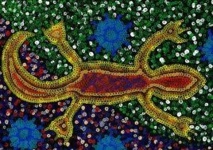Australia challenged to match France in promoting indigenous art
Angus MacKinnon
PARIS, Angus MacKinnon- Australia has been challenged to match France's promotion of Aboriginal art after the inauguration of a landmark work in Paris.
Gija artist Lena Nyadbi's Dayiwul Lirlmim (Barramundi Scales) will be seen by millions of visitors to the French capital for decades to come as a result of a decision to install a hugely enlarged version of her abstract representation of a traditional dreaming story on the roof of a museum that sits directly under the Eiffel Tower.

Nyadbi, now in her late 70s, was in Paris to see how visitors to the tower will view her 700-square-metre (7,500 square feet) work, and she declared herself satisfied with the outcome of a project for which there is no model in her own country.
That is a situation that could do with being addressed, according to Lee-Ann Buckskin, the chair of the Aboriginal and Torres Strait Islander Arts Board, who was involved in the process that led to Thursday's inauguration of Nyadbi's work in such a prominent location.
"I would love to see Australia now looking at what it can do in terms of appreciating Aboriginal art on such a major scale in a major city in our own country," Buckskin said.
"It is something I would absolutely love to see. Imagine walking down to Sydney Opera House and seeing a picture or a painting on that scale. It would truly say that our first peoples are here."
Buckskin helped to select Nyadbi for the prestigious commission from the Quai Branly museum and she offered an insight into the artist's appreciation of the significance of Aboriginal art being granted such exposure.
"Lena realises the magnitude of what this means internationally," she said. "From her it is a gift to mankind. She sees that by taking a leap in doing this, she is building a pathway for others to follow."
The significance of what Paris has done was also underlined by Jonathan Kimberley, the manager and curator of the Warmun Art Centre in northwestern Australia which has sponsored Nyadbi's development.
"This changes the game in contemporary art right across the world," he predicted.
Future generations will never be able to match the extraordinary life journey of Nyadbi, who only began painting at around 60 years of age.
As a child she worked on a cattle station, surviving on meagre rations in conditions akin to those of indentured labourers.
From there, to rubbing shoulders with Jean Nouvel, the architect who created the Quai Branly museum and first had the vision of incorporating Aboriginal art into its structure, represents a very long trip.
But Nyadbi seemed to have no problem enjoying the arrival. According to Buckskin, the artist has made the most of her time in Paris, buying jewellery and clothes, having her nails done and taking in the city sights by bus and barge.
"When we went shopping she got herself a new pair of jeans because that is what she wore when she was working. 'I was number one horse rider' she told us."
Nyadabi's piece is 46 times bigger than the ochre and charcoal original created as a visual interpretation of a traditional story among her Gija people.
The features features a barramundi fish escaping from three women and scattering its scales across Gija territory, creating the diamonds that mean the area is now scarred by the presence of the world's largest mine for the coveted stones.
That reality ensured the artist's visit to the Eiffel Tower earlier this week was an emotional affair. "Lena started crying and she just set the rest of us off," revealed Buckskin. "I was really surprised by how emotional I felt."
Explaining her tears, Nyadabi said: "I was very emotional and full of pride," she said. "At the same time I had tears in my eyes. When I looked down I felt sorry for my country - the landscape has been changed but the dream hasn't."
Nyadbi's work was already a permanent fixture in the museum as she created a mural, Jimbirla and Gemerre (spearheads and scarifications), that adorns one of the external walls.
Works by seven other Australian Aboriginal artists are featured on ceilings throughout the museum, in line with the wishes of Nouvel, who revealed that he had identified something in their work that he described as "very architectural."
-----------------------------------------------------------------------------------------------------